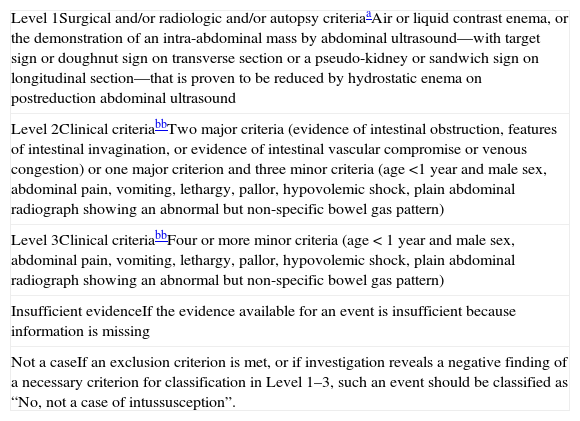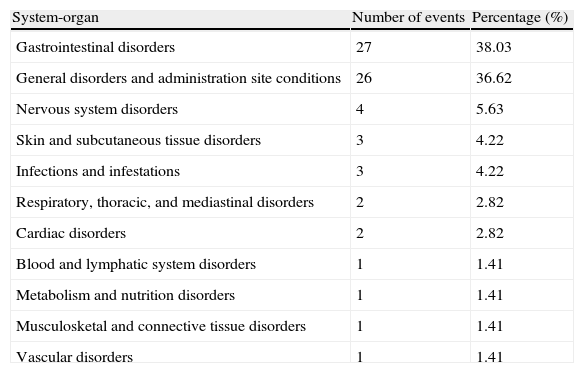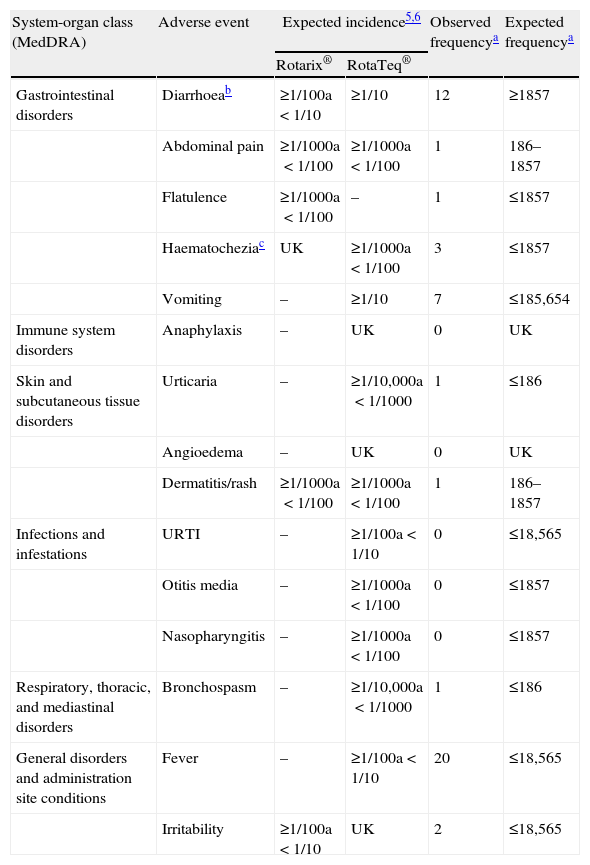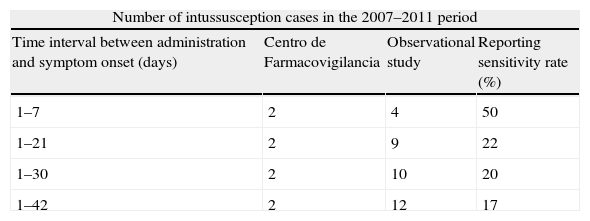The aims of this study were to describe the reports of suspected adverse events due to rotavirus vaccines, and assess the reporting sensitivity for intussusception.
Materials and methodsDescriptive study performed using the reports of suspected adverse events following rotavirus vaccination in infants aged less than 10 months, as registered in the Pharmacovigilance Centre of the Valencian Community during 2007–2011.
The reporting rate for intussusception was compared to the intussusception rate in vaccinated infants obtained using the hospital discharge database (CMBD) and the regional vaccine registry.
ResultsThe adverse event reporting rate was 20 per 100,000 administered doses, with the majority (74%) of the reports being classified as non-serious. Fever, vomiting, and diarrhoea were the adverse events reported more frequently. Two intussusception cases, which occurred within the first seven days post-vaccination, were reported as temporarily associated to vaccination. The reporting sensitivity for intussusception at the Pharmacovigilance Centre in the 1–7 day interval following rotavirus vaccination was 50%.
ConclusionsOur results suggest that rotavirus vaccines have, in general, a good safety profile. Intussusception reporting to the Pharmacovigilance Centre shows sensitivity similar to other passive surveillance systems. The intussusception risk should be further investigated using well-designed epidemiological studies, and evaluated in comparison with the well-known benefits provided by these vaccines.
Los objetivos de este estudio fueron describir las notificaciones de sospechas de reacciones adversas relacionadas con las vacunas frente a rotavirus y valorar la sensibilidad de la notificación para invaginación intestinal.
Material y métodosEstudio descriptivo, a partir de las notificaciones de sospechas de reacciones adversas relacionadas con las vacunas frente a rotavirus, ocurridas en niños menores de diez meses, registradas en el Centro de Farmacovigilancia de la Comunidad Valenciana durante el periodo 2007-2011.
Se comparó la tasa de notificación de invaginaciones con la tasa de invaginaciones en vacunados obtenida utilizando la base de datos de altas hospitalarias (CMBD) y el registro nominal de vacunaciones autonómico.
ResultadosLa tasa de notificación de eventos adversos fue de 20 por 100.000 dosis administradas. El 74% de las notificaciones se clasificaron como no graves, siendo la fiebre, los vómitos y la diarrea las sospechas más frecuentes. Dos casos de invaginación, ocurridos en los siete primeros días tras la vacunación, fueron notificados como asociados temporalmente a la vacunación. La sensibilidad de la notificación de invaginación intestinal para el periodo de riesgo de uno a siete días fue del 50%.
ConclusionesLos resultados sugieren que las vacunas frente a rotavirus presentan un perfil de seguridad en general adecuado, y que el Centro de Farmacovigilancia de la Comunidad Valenciana, comparado con otros sistemas de vigilancia pasiva, es igualmente sensible para detectar señales de posible asociación con invaginación intestinal. Este riesgo requiere ser investigado con estudios epidemiológicos bien diseñados y comparado con los evidentes beneficios que estas vacunas proporcionan.
The first vaccine against rotavirus, Rotashield®, was licensed in the United States in 1998, but was withdrawn a few months later1 once population-based epidemiological studies 2,3 had confirmed the concern generated by the reporting of 15 cases of intussusception to the Vaccine Adverse Events Reporting System (VAERS) passive surveillance system after the distribution of 1.8 million doses.4
Two new vaccines, both live-attenuated and orally administered, were authorised several years later following various pre-licensure clinical trials designed to exclude this association5,6: a monovalent human vaccine, Rotarix® and a pentavalent human-bovine vaccine, RotaTeq®. These vaccines, available in Spain since 2006 and 2007 respectively, were not included in the immunisation schedule, but have been recommended by paediatricians and paid for by parents. In 2010 contamination with a virus was detected in both vaccines and they were recalled from the market.7,8 Months later, after it was ascertained that this finding did not pose safety or efficacy problems, the distribution of RotaTeq® was authorised once again,9 and the re-release of Rotarix® lots is imminent. The summaries of product characteristics of both vaccines recommended starting the vaccination schedule from 6 weeks of age and ending it by 24 weeks (Rotarix®) and 26 weeks (RotaTeq®) of age. In 2012 the top age limit of the RotaTeq® vaccine was raised to 32 weeks.10
The clinical trials and post-licensure surveillance have not shown evidence of serious adverse reactions associated to these vaccines,5,6 except for intussusception, an association that has been monitored carefully. Post-licensure studies showed an increased risk following the first dose in Mexico (Rotarix®)11 and Australia (RotaTeq®),12 and following the second dose (Rotarix®) in Brazil,11 although it was considerably smaller than the risk observed in association with Rotashield®. In the United States, no association between RotaTeq® and intussusception was found with the data available from the VAERS13 passive surveillance system nor the data from early observational studies.14–17 However, VAERS data on a larger number of distributed doses suggested the possibility of this association,18 which has been recently confirmed.19,20
In Spain, post-licensure surveillance consists mostly of passive surveillance. However, it is known that underreporting occurs in these systems. Its degree is mostly related to the seriousness of the event, its temporal proximity to vaccination, and awareness of the association and the obligation to report such events.21 On the other hand, reporting can increase in the first years following authorisation of a new drug22 or be stimulated when the medication is subject to media exposure, either because there is a well-known association or because the regulatory authorities have issued some kind of warning.23 Estimating the amount of under- and overreporting in a passive surveillance system allows for the assessment of the system's validity in detecting adverse events, and consequently its usefulness, but this requires an adequate reference for comparison.21
The aims of this study were to describe the reports of suspected adverse reactions to rotavirus vaccines registered by the CFCV (Centro de Farmacovigilancia de la Comunidad Valenciana/Pharmacovigilance Centre of the Autonomous Community of Valencia) and assess reporting sensitivity in this passive surveillance system for a serious and rare event such as intussusception.
Materials and methodsDesignDescriptive retrospective study of the reports of suspected adverse events to rotavirus vaccines registered in the database of the Sistema Español de Farmacovigilancia de Medicamentos de Uso Humano (Spanish System for the Surveillance of Medications Used in Humans, SEFV-H) through the CFCV between January 1, 2007 and December 31, 2011.
To compare the rate of reporting intussusception to the CFCV with a baseline reference, we used the data of a retrospective observational study designed to estimate the association between intussusception and the administration of rotavirus vaccines. This study included all confirmed intussusception cases in resident children less than 10 months of age admitted to public hospitals of the Autonomous Community of Valencia during the same period.
Both studies were authorised by the Clinical Research Ethics Board of the Dirección General de Salud Pública-Centro Superior de Investigación en Salud Pública.
Data sourcesIn Spain, suspected adverse effects are reported through the Programa de Notificación Espontánea de Reacciones Adversas a Medicamentos (Programme of Spontaneous Reporting of Adverse Reactions to Medication). Health professionals, manufacturers, and since 2013 citizens, too,24 report suspected reactions to the corresponding pharmacovigilance centre of their autonomous community.25 The CFCV receives the reports, analyses them, encodes them, and enters them in the database of the Drug Adverse Event Manager of the Information System for the Control and Regulation of Drugs and Health Products, which records them electronically in FEDRA, the database of the SEFV-H.26
The vaccine doses administered in public and private health centres of the Autonomous Community of Valencia are registered in the SIV (Vaccine Information System). This system also allows health professionals to perform reports of suspected adverse reactions to vaccines, which are then submitted electronically to the CFCV.27
The Minimum Basic Data Set (CMBD) is a record of the discharges from hospitals of the National Healthcare System.28 We identified all episodes of intussusception in children younger than 10 months hospitalised during the period under study in this database by searching for the specific IDC-9-CM code (560.0) in any of the diagnostic fields. These cases were reviewed and confirmed using the standardised case definition for intussusception of the Brighton Collaboration (BC)29 (Table 1). The vaccination status for rotavirus of these patients, and if applicable the vaccination date, were obtained from the SIV. In patients with inconsistent data, vaccination date and the number of doses were confirmed by the parents or legal guardians.
Standardised Brighton Collaboration case definition for the diagnosis of acute intussusception in infants and young children.
| Level 1Surgical and/or radiologic and/or autopsy criteriaaAir or liquid contrast enema, or the demonstration of an intra-abdominal mass by abdominal ultrasound—with target sign or doughnut sign on transverse section or a pseudo-kidney or sandwich sign on longitudinal section—that is proven to be reduced by hydrostatic enema on postreduction abdominal ultrasound |
| Level 2Clinical criteriabbTwo major criteria (evidence of intestinal obstruction, features of intestinal invagination, or evidence of intestinal vascular compromise or venous congestion) or one major criterion and three minor criteria (age <1 year and male sex, abdominal pain, vomiting, lethargy, pallor, hypovolemic shock, plain abdominal radiograph showing an abnormal but non-specific bowel gas pattern) |
| Level 3Clinical criteriabbFour or more minor criteria (age < 1 year and male sex, abdominal pain, vomiting, lethargy, pallor, hypovolemic shock, plain abdominal radiograph showing an abnormal but non-specific bowel gas pattern) |
| Insufficient evidenceIf the evidence available for an event is insufficient because information is missing |
| Not a caseIf an exclusion criterion is met, or if investigation reveals a negative finding of a necessary criterion for classification in Level 1–3, such an event should be classified as “No, not a case of intussusception”. |
The reported suspected adverse events were described in terms of their severity30 and of the affected MedDRA system-organ classes.31 We calculated the latency for each event as the time interval between the onset of symptoms and the vaccination date, and duration as the interval between symptom onset and symptom resolution. We did the descriptive analysis of the data using the statistical software Stata/SE 12 (StataCorp LP, Texas, United States).
The expected frequencies for non-intussusception suspected adverse events described in the summary of product characteristics were calculated using the total number of doses of rotavirus vaccines registered in the SIV as the denominator (December 20, 2012).
We calculated the reporting sensitivity21 for reports of detected intussusception to the CFCV by dividing the rate of intussusception reporting to the CFCV by the rate of confirmed intussusceptions in children vaccinated against rotavirus (levels 1 or 2 of diagnostic certainty in the BC classification) found in the observational study.
ResultsDuring the 2007–2011 period, at least 185,654 doses of the 2 available rotavirus vaccines were administered in the Autonomous Community of Valencia, and a total of 37 suspected adverse reactions were reported. The reporting rate was 20 per 100,000 administered doses.
Description of reportsThere were 3 reports of suspected adverse reactions in 2007, 6 in 2008, 18 in 2009, 5 in 2010, and 5 in 2011. The reporting rates were 17, 14, 34, 18, and 11 per 100,000 administered doses, respectively.
The 37 reports comprised a total of 91 suspected adverse reactions, with a median of 2 events by report, a mean of 2.5 (SD: 2.0), and a range of 1 to 10.
Three reports contained vaccination errors, so we analysed them separately.
In the remaining 34 reports, 65% of the children were male. For the 33 reports that included information on age, the median and mean age were 4 months (SD: 1.7), with a range of 2–10 months of age. In 19 (56%) reports, the rotavirus vaccine was administered simultaneously with other vaccines.
Reports of suspected non-serious adverse reactionsOut of the 34 reports, 25 (74%) were classified as non-serious, and they included 35 suspected adverse reactions. The events most frequently reported were fever (n=16), diarrhoea (n=8; includes diarrhoea and gastroenteritis), and vomiting (n=5). The other reported events were hyperthermia, irritability, abdominal pain, abnormal stools, generalised erythema, and urticaria.
The median latency period corresponded to the vaccination date, with symptoms appearing 3 days post-vaccination at the latest. In the 23 reports that included information for duration, the suspected adverse reactions did not last more than 7 days, with a median duration of 1 day.
Reports of suspected serious adverse reactionsNine of the 34 reports (26%) were classified as serious, and they included a total of 36 suspected adverse reactions.
The 2 reported cases of intussusception occurred in a 4-month-old girl whose symptoms, which included melenas, hyperhidrosis, and thrombocytopenia, started 6 days after vaccination, and in a 3-month-old boy whose symptoms, with haemorrhagic diarrhoea, started 7 days after vaccination. Both conditions were resolved, although there is no information on the procedures employed in their management.
Other reported events included one case of gastrointestinal disorder accompanied by diarrhoea with mucus and blood in the stool with condition aggravated (specifics were not given); one of loss of consciousness accompanied by hypotonia, apnoea, and foaming at the mouth; one of febrile seizure with decreased mobility; one of bronchospasm accompanied by fever, vomiting, and diarrhoea; one urinary tract infection with fever, abdominal distention, decreased appetite, and aerophagia; and 2 cases of tachycardia, one supraventricular and one unspecified accompanied by fever, irritability, hypotonia, pallor, and vomiting.
In the 7 reports that provided information on the latency period, the median latency was 1 day, with the onset of symptoms occurring between the day of vaccination and the 113 days that followed. Symptom duration in serious events was not greater than 6 days in the 3 reports that offer this information, and the median duration was 5 days.
Frequency of suspected adverse reaction reports by affected MedDRA system organ classThe 34 reports that had to do with the safety of rotavirus vaccines described a total of 71 suspected adverse reactions, of which 27 (38%) corresponded to gastrointestinal disorders and 26 (37%) to general disorders and administration site conditions. The remaining suspected reactions were classified into nervous system disorders, skin and subcutaneous disorders, infections and infestations, respiratory, thoracic, and mediastinal disorders, cardiac disorders, blood and lymphatic system disorders, metabolism and nutrition disorders, vascular disorders, and musculoskeletal and connective tissue disorders (Table 2).
Reports of suspected adverse reactions by affected MedDRA system-organ class.
| System-organ | Number of events | Percentage (%) |
| Gastrointestinal disorders | 27 | 38.03 |
| General disorders and administration site conditions | 26 | 36.62 |
| Nervous system disorders | 4 | 5.63 |
| Skin and subcutaneous tissue disorders | 3 | 4.22 |
| Infections and infestations | 3 | 4.22 |
| Respiratory, thoracic, and mediastinal disorders | 2 | 2.82 |
| Cardiac disorders | 2 | 2.82 |
| Blood and lymphatic system disorders | 1 | 1.41 |
| Metabolism and nutrition disorders | 1 | 1.41 |
| Musculosketal and connective tissue disorders | 1 | 1.41 |
| Vascular disorders | 1 | 1.41 |
The comparison of the observed frequencies of suspected (non-intussusception) adverse reactions described in the summaries of product characteristics, with the expected frequencies based on clinical trials and post-licensure surveillance, shows that in every case in which the comparison could be made, the observed frequencies (based on reports) were much lower than expected (Table 3).
Suspected non-intussusception adverse reactions described in the summary of product characteristics of rotavirus vaccines: observed and expected frequencies by administered dose.
| System-organ class (MedDRA) | Adverse event | Expected incidence5,6 | Observed frequencya | Expected frequencya | |
| Rotarix® | RotaTeq® | ||||
| Gastrointestinal disorders | Diarrhoeab | ≥1/100a<1/10 | ≥1/10 | 12 | ≥1857 |
| Abdominal pain | ≥1/1000a<1/100 | ≥1/1000a<1/100 | 1 | 186–1857 | |
| Flatulence | ≥1/1000a<1/100 | – | 1 | ≤1857 | |
| Haematocheziac | UK | ≥1/1000a<1/100 | 3 | ≤1857 | |
| Vomiting | – | ≥1/10 | 7 | ≤185,654 | |
| Immune system disorders | Anaphylaxis | – | UK | 0 | UK |
| Skin and subcutaneous tissue disorders | Urticaria | – | ≥1/10,000a<1/1000 | 1 | ≤186 |
| Angioedema | – | UK | 0 | UK | |
| Dermatitis/rash | ≥1/1000a<1/100 | ≥1/1000a<1/100 | 1 | 186–1857 | |
| Infections and infestations | URTI | – | ≥1/100a<1/10 | 0 | ≤18,565 |
| Otitis media | – | ≥1/1000a<1/100 | 0 | ≤1857 | |
| Nasopharyngitis | – | ≥1/1000a<1/100 | 0 | ≤1857 | |
| Respiratory, thoracic, and mediastinal disorders | Bronchospasm | – | ≥1/10,000a<1/1000 | 1 | ≤186 |
| General disorders and administration site conditions | Fever | – | ≥1/100a<1/10 | 20 | ≤18,565 |
| Irritability | ≥1/100a<1/10 | UK | 2 | ≤18,565 | |
185,654 doses administered in the 2007–2011 period. The expected frequency was calculated as a function of the minimum and maximum incidences found in the clinical trials for both vaccines.
URTI: upper respiratory tract infection; UK: unknown.
The CFCV received reports of 2 cases of intussusception diagnosed up to 7 days following the administration of a rotavirus vaccine dose. The observational study found that 4 confirmed cases with Level 1 or 2 of diagnostic certainty for the standardised BC case definition of intussusception were detected in the same time period for the same risk window (1–7 days post-vaccination). Consequently, the reporting sensitivity for reports to the CFCV for this risk window was of 50%. The sensitivities for the 1–21, 1–30, and 1–42 days risk windows were 22%, 20%, and 17% respectively (Table 4).
Number of intussusception cases reported to the Centro de Farmacovigilancia and number of intussusception cases observed in the observational study: reporting sensitivity for intussusception.
| Number of intussusception cases in the 2007–2011 period | |||
| Time interval between administration and symptom onset (days) | Centro de Farmacovigilancia | Observational study | Reporting sensitivity rate (%) |
| 1–7 | 2 | 4 | 50 |
| 1–21 | 2 | 9 | 22 |
| 1–30 | 2 | 10 | 20 |
| 1–42 | 2 | 12 | 17 |
The 3 reports that described vaccination errors were classified as serious. The 3 cases corresponded to one 6-month-old boy who developed symptoms suggestive of rotavirus infection 75 days after vaccination, one 19-month-old girl who presented these symptoms 435 days after vaccination, and a boy of unknown age who had the onset of symptoms approximately 3 months after vaccination. The available data were not enough to determine whether they had completed the vaccination schedule, or whether the diagnosis was confirmed by laboratory tests.
DiscussionPassive surveillance data from the CFCV after more than 185,000 doses registered in the SIV over a period of 5 years suggest that the available vaccines against rotavirus offer a good safety profile overall, as the most frequently reported suspected adverse reactions were fever, diarrhoea, and vomiting, consistent with the results of the pre-licensure clinical trials. Seventy-four percent of reported events were classified as non-serious, and the observed frequency of reports relative to the number of expected non-intussusception adverse event reports was very low.
Intussusception, reported twice within the first 7 days following vaccination against rotavirus, has been associated with the administration of both vaccines.11,19 Since the intestinal replication of the vaccine virus in the 7 days post-vaccination18 makes it biologically plausible, we must carefully assess this risk in the Autonomous Community of Valencia. We want to highlight that the CFCV has shown a sensitivity of 50% for the detection of intussusception in the first 7 days after vaccination, which is very close to the sensitivity estimated for VAERS while Rotashield® was in the market.32 This relatively high reporting sensitivity for intussusception does not necessarily apply to other adverse events, as intussusception is manifested in close temporal proximity to vaccination, and the experience with Rotashield®, added to the strict monitoring that the new vaccines have been subject to, contribute to the awareness of a potential association.21,32 Still, it is a relief that there have been no reports of Kawasaki disease after the administration of at least 118,996 RotaTeq® doses (SIV, December 20, 2012), as an increase—although not statistically significant—in the rate of this disease was observed during pre-licensure trials.6 This potential association has also not been supported by the passive surveillance through VAERS33 nor established by one observational study.34
The detection of serious adverse events by passive surveillance systems can be inaccurate, especially if reports do not provide sufficient information. The reported suspected adverse reactions that had not been described in the summaries of product characteristics were tachycardia, urinary tract infection, and thrombocytopaenia. However, these reports do not suggest that these are new signs that require exhaustive investigation, as in addition to the low reporting rate, supraventricular tachycardia tends to appear in infants younger than 1 year for causes that are not related to vaccination,35 unspecified tachycardia was accompanied by fever, urinary tract infections are a condition that is not associated with vaccination,36 and thrombocytopaenia was described as part of an intussusception report that did not suggest a case of immune thrombocytopaenic purpura (ITP). Furthermore, ITP, while associated with the measles-mumps-rubella vaccine in very low frequencies and very occasionally with other viral vaccines, has not been associated with rotavirus vaccines.37 At any rate, temporal proximity and suspected association with the vaccine are reason enough to report,23 and it is important that health professionals remember their obligation to report suspected adverse reactions to drugs and vaccines, especially in the cases of serious events.
When it comes to simultaneous administration with other vaccines, it is difficult to attribute the suspected event to a specific vaccine, especially when the disorder has been described in association with more than one of them. Simultaneous administration of Rotarix® or RotaTeq® with other vaccines, such as combined diphtheria, tetanus toxoid, acellular pertussis vaccine, inactivated poliovirus vaccine, Haemophilus influenzae type b conjugate, hepatitis B vaccine, and pneumococcal conjugate vaccine have been shown not to interfere significantly with the protective immune responses or safety profile of the respective vaccines.38
An important limitation of our study is the lack of information on the brand and the number of administered vaccine doses in pharmacovigilance reports, which makes it impossible to associate suspected adverse events or calculate expected frequencies of events by the brand and number of administered doses of vaccine. However, although the composition of both vaccines is different,5,6 they have a similar mechanism of action,39 although they seem to differ in the association of intussusception with the number of administered doses.18
The SIV can be accessed from all public and some private centres where vaccines are administered, but since vaccination against rotavirus is not included in the immunisation schedule, the number of doses reported to the SIV may be lower than the number of administered doses. When we compared the number of distributed doses (IMS Health) with the number of doses recorded in the SIV in the 2008–2010 period, we determined that approximately 83% of the distributed vaccines were registered in the SIV as having been administered.
The results of this study suggest that rotavirus vaccines have a good safety profile overall, and that compared to other passive surveillance systems, the CFCV has a high-enough reporting sensitivity to detect signs of a potential association with intussusception. This risk needs to be investigated by means of well-designed epidemiological studies, and weighted against the evident benefits5,6,40 provided by these vaccines.
Conflicts of interestJDD, JPB, MSC and SPV work in the Área de Investigación en Vacunas (Department of Vaccine Research) of FISABIO-Public Health. This institution has participated and continues to participate in clinical trials and epidemiological studies funded by GSK, MSD and SP-MSD.
Marian Martín-Navarro, Fundación para el Fomento de la Investigación Sanitaria y Biomédica de la Comunitat Valenciana FISABIO-Public Health and Alexandra C. Pacurari, Erasmus University Medical Center.
Please cite this article as: Pérez-Vilar S, Díez-Domingo J, Gomar-Fayos J, Pastor-Villalba E, Sastre-Cantón M, Puig-Barberà J. Vigilancia pasiva de la seguridad postautorización de las vacunas frente a rotavirus: sensibilidad de la notificación de invaginación intestinal. An Pediatr (Barc). 2014;81:77–85.
Previous presentation in meetings, congresses, or symposiums: summary (part of the original content) accepted for the 7th Vaccine and ISV Congress, October 27th–29th 2013, Sitges, Spain.







